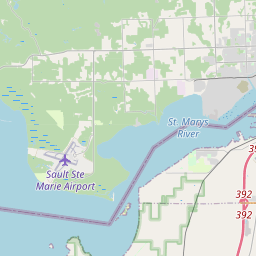Glacial Gifts
Historical marker location:
12942 West Lakeshore Drive, Brimley, Michigan
( Marker can be reached from West Lakeshore Drive (Iroquois Road), 0.7 miles east of South Monocle Lake Road, on the left when traveling east.)







© OpenStreetMap contributors
Coastal Landscape Formed by Ice, Water and Wind
The University of Michigan, located in Ann Arbor, is one of the oldest and most prestigious universities in the United States. It was founded in 1817, 20 years before Michigan became a state, and its alumni include President Gerald Ford, Google co-founder Larry Page, and actor James Earl Jones.
About Chippewa County
Chippewa County Timeline
Chippewa County, located in the Upper Peninsula of Michigan, has a rich history that stretches back thousands of years. The area was originally inhabited by the indigenous Ojibwe or Chippewa people, who relied on hunting, fishing, and gathering for their sustenance. European contact with the Ojibwe began in the 17th century when French fur traders arrived in the region.
In the late 18th century, the British took control of the area through the Treaty of Paris, but it was later ceded to the United States following the War of 1812. Chippewa County was officially established in 1826 and named after the Ojibwe tribe that inhabited the area. The county became an important center for the fur trade, as traders established posts along the St. Mary's River and engaged in commerce with Canada.
The mid-19th century brought significant changes to Chippewa County with the opening of the Soo Locks in 1855. This lock system allowed ships to bypass the treacherous rapids of the St. Mary's River and navigate freely between Lake Superior and Lake Huron. The Soo Locks became a crucial transportation hub, attracting industries such as mining, lumbering, and manufacturing to the region.
Chippewa County continued to evolve in the 20th century, with the establishment of military installations during World War II. Kincheloe Air Force Base was constructed in 1943 and served as a significant training ground for pilots during the war. After the war, the base was utilized for various purposes until its closure in 1977. Today, Chippewa County remains an important hub for tourism, outdoor recreational activities, and natural beauty, with attractions such as the scenic Tahquamenon Falls and the historic Mackinac Island drawing visitors from near and far.
In the late 18th century, the British took control of the area through the Treaty of Paris, but it was later ceded to the United States following the War of 1812. Chippewa County was officially established in 1826 and named after the Ojibwe tribe that inhabited the area. The county became an important center for the fur trade, as traders established posts along the St. Mary's River and engaged in commerce with Canada.
The mid-19th century brought significant changes to Chippewa County with the opening of the Soo Locks in 1855. This lock system allowed ships to bypass the treacherous rapids of the St. Mary's River and navigate freely between Lake Superior and Lake Huron. The Soo Locks became a crucial transportation hub, attracting industries such as mining, lumbering, and manufacturing to the region.
Chippewa County continued to evolve in the 20th century, with the establishment of military installations during World War II. Kincheloe Air Force Base was constructed in 1943 and served as a significant training ground for pilots during the war. After the war, the base was utilized for various purposes until its closure in 1977. Today, Chippewa County remains an important hub for tourism, outdoor recreational activities, and natural beauty, with attractions such as the scenic Tahquamenon Falls and the historic Mackinac Island drawing visitors from near and far.
Chippewa County Timeline
This timeline provides a condensed summary of the historical journey of Chippewa County, Michigan.
- The Anishinaabe people, including the Chippewa tribe, have lived in the area for thousands of years
- French explorers arrive in the area in the 17th century
- Chippewa County is established in 1826
- The first European settlement, Sault Ste. Marie, is founded in 1668
- The area becomes part of the United States with the signing of the Treaty of Ghent in 1815
- The first courthouse is built in Sault Ste. Marie in 1837
- The construction of the St. Mary's Falls Ship Canal begins in 1852
- The first railroad reaches Sault Ste. Marie in 1887
- The establishment of the Soo Locks in 1855 greatly enhances shipping on the Great Lakes
- Chippewa County experiences a boom during the timber industry era in the late 19th and early 20th centuries
- The Mackinac Bridge, connecting Chippewa County with the Lower Peninsula, is completed in 1957